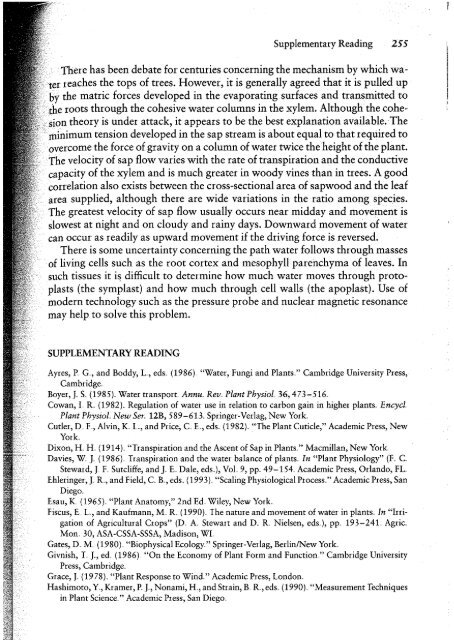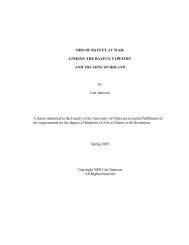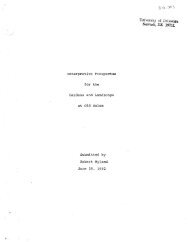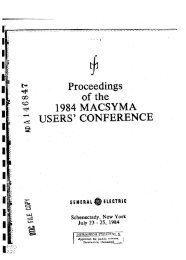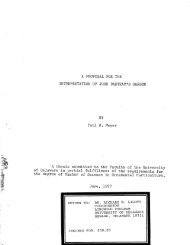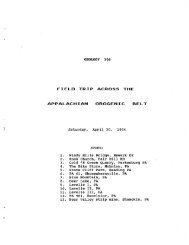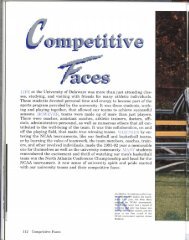Transpiration and the Ascent
Transpiration and the Ascent
Transpiration and the Ascent
Create successful ePaper yourself
Turn your PDF publications into a flip-book with our unique Google optimized e-Paper software.
SupplementatyReading 255<br />
There has been debate for centuries concerning <strong>the</strong> mechanism by which water<br />
reaches <strong>the</strong> tops of trees. However, it is generally agreed that it is pulled up<br />
by <strong>the</strong> matric forces developed in <strong>the</strong> evaporating surfaces <strong>and</strong> transmitted to<br />
<strong>the</strong> roots through <strong>the</strong> cohesive water columns in <strong>the</strong> xylem. Although <strong>the</strong> cohesion<br />
<strong>the</strong>ory is under attack, it appears to be <strong>the</strong> best explanation available. The<br />
: l:hinimumtension developed in <strong>the</strong> sap stream is about equal to that required to<br />
overcome <strong>the</strong> force of gravity on a column of water twice <strong>the</strong> height of <strong>the</strong> plant.<br />
The velocity of sap flow varies with <strong>the</strong> rate of transpiration <strong>and</strong> <strong>the</strong> conductive<br />
capacity of <strong>the</strong> xylem <strong>and</strong> is much greater in woody vines than in trees. A good<br />
correlation also exists between <strong>the</strong> cross-sectional area of sapwood <strong>and</strong> <strong>the</strong> leaf<br />
area supplied, although <strong>the</strong>re are wide variations in <strong>the</strong> ratio among species.<br />
greatest velocity of sap flow usually occurs near midday <strong>and</strong> movement is<br />
slowest at night <strong>and</strong> on cloudy <strong>and</strong> rainy days. Downward movement of water<br />
can occur as readily as upward movement if <strong>the</strong> driving force is reversed.<br />
There is some uncertainty concerning <strong>the</strong> path water follows through masses<br />
of living cells such as <strong>the</strong> root cortex <strong>and</strong> mesophyll parenchyma of leaves. In<br />
such tissues it i~ difficult to determine how much water moves through protoplasts<br />
(<strong>the</strong> symplast) <strong>and</strong> how much through cell walls (<strong>the</strong> apoplast). Use of<br />
modern technology such as <strong>the</strong> pressure probe <strong>and</strong> nuclear magnetic resonance<br />
may help to solve this problem.<br />
SUPPLEMENTARY READING<br />
Ayres, P..G., <strong>and</strong> Boddy, L, eds..(1986). "Water, Fungi <strong>and</strong> Plants" Cambridge University Press,<br />
Cambridge.<br />
Boyer,J S..(1985) ..Water transport. Annu ..Rev ..Plant Physiol.. 36,473-516.<br />
Cowan, I R. (1982) ..Regulation of water use in relation to carbon gain in higher plants. Encycl<br />
Plant Physiol.. New SeT.. 12B, 589-613 ..Springer-Verlag, New York<br />
Cutler, D..E, Alvin, K. L, <strong>and</strong> Price, C. E., eds..(1982) .."The Plant Cuticle," Academic Press, New<br />
York.<br />
Dixon, H. H (1914) .."<strong>Transpiration</strong> <strong>and</strong> <strong>the</strong> <strong>Ascent</strong> of Sap in Plants." Macmillan, New York<br />
Davies, W J (1986). <strong>Transpiration</strong> <strong>and</strong> <strong>the</strong> water balance of plants. In "Plant Physiology" (F..C.<br />
Steward, J E Sutcliffe, <strong>and</strong> J E. Dale, eds.), VoL 9, pp" 49-154., Academic Press, Orl<strong>and</strong>o, FL<br />
Ehleringer, JR., <strong>and</strong> Field, C. B.., eds..(1993 ).."Scaling Physiological Process." Academic Press, San<br />
Diego.<br />
Esau, K. (1965) .."Plant Anatomy," 2nd Ed..Wiley, New York<br />
Fiscus, E.,L, <strong>and</strong> Kaufmann, M R. (1990) ..The nature <strong>and</strong> movement of water in plants ..In "Irrigation<br />
of Agricultural Crops" (D..A.. Stewart <strong>and</strong> D.. R Nielsen, eds..), pp .. 193-24L Agric.<br />
Mon ..30, ASA-CSSA-SSSA,Madison, WI<br />
Gates, D..M ..(1980). "Biophysical Ecology." Springer-Verlag, Berlin/New York<br />
Givnish, L J, ed,. (1986). "On <strong>the</strong> Economy of Plant Form <strong>and</strong> Function" Cambridge University<br />
Press, Cambridge.<br />
Grace, J. (1978) .."Plant Response to Wind .." Academic Press, London ..<br />
Hashimoto, Y., Kramer, P. J., Nonami, H" <strong>and</strong> Strain, 8..R., eds. (1990) .."Measurement Techniques<br />
in Plant Science" Academic Press, San Diego.


